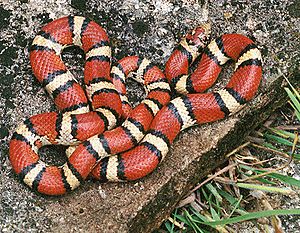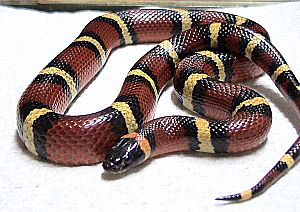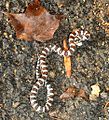Milk snake facts for kids
Quick facts for kids Milk snake |
|
|---|---|
 |
|
| A red milk snake | |
| Scientific classification | |
| Genus: |
Lampropeltis
|
| Species: |
triangulum
|
The milk snake (scientific name: Lampropeltis triangulum) is a type of kingsnake. There are currently 24 different kinds, or subspecies, of milk snakes! One snake, the scarlet kingsnake, used to be considered a subspecies of the milk snake. But now, scientists agree it's its own separate species.
Milk snakes can look very different from each other. Many even have their own special names. These snakes are not venomous, meaning they are harmless to humans.
Contents
Where Milk Snakes Live
Milk snakes live in many places. You can find them from southeastern Canada all the way through most of the United States. They also live in Central America, and even south into western Ecuador and northern Venezuela in South America.
What Milk Snakes Look Like
Milk snakes usually grow longer than 60 centimeters (about 2 feet). Some very big ones can even reach 120 to 132 centimeters (about 4 to 4.3 feet) long! In the wild, most adult milk snakes in North America are typically less than 90 centimeters (about 3 feet) long.
Males are usually bigger than females when they are fully grown. Milk snakes that live in warmer places like Mexico tend to grow larger than those in cooler areas.
Milk snakes have smooth, shiny scales. Their most common pattern is alternating bands of red, black, and yellow or white, black, and red. Sometimes, instead of bands, they have red blotches.
Some milk snakes look a lot like coral snakes. This is a special trick called Batesian mimicry. It helps them scare away animals that might want to eat them, because coral snakes are very venomous! Both milk snakes and coral snakes have bands of red, black, and yellow.
However, it's important to know that the rhymes people use to tell the difference between a harmless milk snake and a dangerous coral snake are not always correct. Some coral snakes don't have the usual colors or patterns. So, it's best to be careful and not touch any snake if you're not sure what it is.
The eastern milk snake (L. t. triangulum) can look like several other snakes. These include the coral snake, corn snake, fox snake, and scarlet snake. They can also be mistaken for venomous snakes like the genera Agkistrodon and Sistrurus. Young milk snakes are often reddish and are sometimes confused with copperheads, which are venomous.
Eastern milk snakes have a special light-colored, V-shaped or Y-shaped patch on their necks. This can help you identify them. One type of milk snake is melanistic, which means it's almost all black.
Where Milk Snakes Live (Habitat)
Milk snakes live in many different places. They often live in forests. But in some areas, you might find them in open grasslands. In rocky places, they often live on slopes.
Sometimes, milk snakes move to different places depending on the season. In winter, they go to higher, drier spots to hibernate (sleep through the cold months). In summer, they move to moister areas. Milk snakes usually hibernate from late October or November until mid-April.
How Milk Snakes Behave
Milk snakes are mostly nocturnal, meaning they are active at night, especially in the summer. They usually stay on the ground and try to blend in with leaves and other things. They like to be secretive and stay hidden.
If a milk snake feels threatened, it will usually try to get away first. If it can't escape, it might shake its tail. It can also strike quickly. But remember, milk snakes are not venomous. They only have tiny teeth, and their tails don't have a rattle like a rattlesnake. Unless they are scared, milk snakes move slowly. They can also climb and swim.
What Milk Snakes Eat (Diet)
Young milk snakes enjoy eating slugs, insects, crickets, and earthworms. Adult milk snakes mostly eat lizards (especially skinks) and small mammals like rodents. Milk snakes in the western United States often eat small lizards when they are young. They also eat birds and their eggs, frogs, fish, and even other snakes!
Milk snakes are not picky eaters. They will eat many different animals, including rodents, eggs, birds, reptiles, amphibians, and invertebrates (animals without backbones). However, adult milk snakes mostly eat rodents. They hunt at night and are often found during the day resting in old barns or under wood.
There's an old myth that milk snakes suck milk from cows. This isn't true at all! Milk snakes can't physically suck milk from a cow. But they are often found in and around barns. This is because barns are cool, dark places, and they have lots of rodents for the snakes to eat. This closeness to cows and barns probably started the myth.
Milk Snake Life Cycle (Reproduction)
Milk snakes lay eggs. On average, a female lays about 10 eggs in one clutch, but this number can change depending on the area. Milk snakes mate from early May to late June. In June and July, the female lays her eggs under logs, boards, rocks, or rotting plants.
The eggs are oval-shaped and white. They are usually between 2.5 and 4.2 centimeters (1 to 1.7 inches) long. The eggs hatch after about two months, usually around August or September.
Milk snakes typically live for about 12 years in the wild. In captivity, they can live up to 21 years! They become adults and can have their own babies when they are about three or four years old. A baby milk snake in Virginia is usually about 20.9 centimeters (8.2 inches) long and weighs about 4.1 grams (0.14 ounces) when it hatches.
Milk Snake Conservation Status
The IUCN, a group that works to protect wildlife, says that the milk snake is of least concern. This means they are not currently in danger of disappearing. However, in some places, too many milk snakes are being caught for the pet trade. Because these snakes are so popular as pets, many different types of milk snakes are now being bred in captivity to be sold.
Subspecies
There are many different types of milk snakes, called subspecies. Here are a few examples:
- Guatemalan milk snake, L. t. abnorma
- Andean milk snake, L. t. andesiana
- Mexican milk snake, L. t. annulata

- black milk snake, L. t. gaigeae
- Honduran milk snake, L. t. hondurensis
- Sinaloan milk snake, L. t. sinaloae
- red milk snake, L. t. syspila
- eastern milk snake, L. t. triangulum
Images for kids
-
A young eastern milk snake (L. t. triangulum)
See also
 In Spanish: Serpiente coral falsa para niños
In Spanish: Serpiente coral falsa para niños



